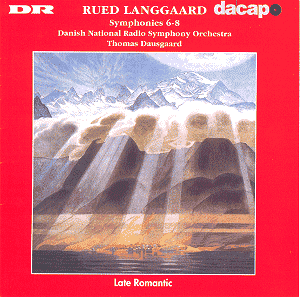 |
Rued LANGGAARD (1893-1952) Symphony No. 6 'Det Himmelrivende' Symphony No. 7 (1926 version) Symphony No. 8 'Minder ved Amelienborg' Danish Radio Symphony Orchestra and Chorus Thomas Dausgaard (conductor) Rec 18 & 21-22 August 1998 (No. 6), 7-10 April 2000 (No. 7), 21-23 June & 15 August 2000 (No. 8), Danish Radio House Crotchet AmazonUK AmazonUS Amazon recommendations |
Langgaard is one of the many 20th century composers who is waiting to be discovered by the 'general musical public' Certainly listeners will respond to his appealing and sometimes visionary music, for he is never dull and as a symphonist he continually explores new ground. Perhaps that explains why he was so committed to symphonic music, but in truth his sixteen symphonies need to be understood as part of the creative output of a prolific composer, with more than 400 works to his credit.
Langgaard is one of several Danish symphonists of the generation after the greatest of them all, Carl Nielsen. (Other prolific figures who are well worth exploring are Niels Viggo Bentzon and Vagn Holmboe.) Langgaard's approach to the symphonic question varied considerably from composition to composition, as witnessed by the most striking of comparisons: Symphony No. 1 plays for an hour, Symphony No. 11 plays for just six minutes! Some of his symphonies include voices, and No. 3 has a demanding obbligato role for the piano.
Yet Langgaard was not a revolutionary. More than his great contemporary Nielsen, he is in fact the true heir of the romantics, for example Wagner and Strauss. That is not to say his music is old fashioned; he simply operates imaginatively from the context of a rich tonal palette of sound.
These general features of Langgaard's creative achievement are thoughtfully considered by Bendt Viinholt Nielsen in his thorough accompanying essay, which deals with the composer in general as well as more specifically as a symphonist. In these days when the documentation supporting CDs is often thin on substance and even ideas, this is a welcome aspect of this new issue.
When his music received indifferent performances or failed to make an initial impression, Langgaard was prone to revise it, and his works can therefore exist in different editions. Thus this DaCapo issue features different versions of the Seventh and Eighth Symphonies to those performed under the direction of Ilya Stupel on Danacord, since Thomas Dausgaard conducts the original versions in both cases.
Symphony No. 6 is an expressionist piece contrasting images of light and darkness, of harmony and dissonance, whereas Nos. 7 and 8 are less challenging, more easily described as neo-romantic; perhaps in the case of the former neo-classical might apply. Dausgaard's performance is particularly well played by the Danish orchestra (who have recorded it several times before. It is a well organised, tightly controlled interpretation, far from indulgent. The result is that the music's inherent contrasts are welded together to form a symphonic whole.
Symphony No. 7 opens in a very direct manner, with a march-like theme which soon gives way to a cleanly articulated fugue, with which it then alternates. Since the original manuscript was only unearthed in 1998, this is the first recording of the original score. Rival versions have featured the later, more programmatic revision. The musical style is generally lyrical, with a sincerity and directness which hold much appeal, while the performance gains from the clean focus of the recorded sound.
Symphony No. 8 was conceived as in tribute to the Royal Palace of Amelienborg, and it therefore opens with a majestic celebration. The third movement features a solo tenor and chorus in a text of praise: 'The golden treasure that once was, with trembling hands I raise.' Lars Pedersen's tenor voice is nicely caught in the recorded perspective, while the rather static chorus confirms the mood, the style having certain resonances with the more noble breadth sometimes found in Nielsen (eg in the gloriously lyrical cantata Springtime in Funen). And perhaps the most impressive section of the whole disc is Dausgaard's performance of the final movement, which magnificently brings forth the contrast from slow introduction into majestic finale. This music may be less challenging than some other pieces by Langgaard, but for the listener new to his work, it makes an excellent introduction, at once direct and appealing.
Terry Barfoot